Pond maintenance and cleaning might be complex if you don’t know how to do it. Take a careful look at your pond and ask yourself whether your water is clean.
But if your fish are acting strangely, which might indicate that something is wrong with the water in your Pond.
Specific equipment, such as pumps and filtration systems and a stringent maintenance plan, are required to keep a formal pond healthy.
However, you’ll be better able to address whatever pond water difficulties you have with a bit of information and experience.
To begin, use the techniques listed below to help maintain your pond water clean.

Types of Ponds and Why do you need Pond Maintenance and Cleaning?
Jump To
- 1 Types of Ponds and Why do you need Pond Maintenance and Cleaning?
- 2 When to do Pond Maintenance and Cleaning?
- 3 Common Problems You may face while owning a Pond.
- 4 4 Easy Steps for Pond Cleaning
- 5 How To Do Pond Maintenance? Tips For Sustaining a Clean Pond
- 6 Your Pond Maintenance Time Schedule Will Keep You On Top Of Your Pond Care
- 7 Conclusion
People have always been fascinated by nature, and almost everyone enjoys exploring the beautiful natural terrain surrounding them.
A pond is a way to mimic a natural aquatic ecosystem. However ponds can get found naturally, or homeowners can construct a lovely pond in their homes if they have the required area.
Pond Maintenance and Cleaning are essential for keeping it clean and healthy for your fish and plants.
Depending on where you live and what kind of fish and plants you have, your Pond will have its ecology, and if you don’t keep it in good form, life in the Pond will get affected.
A biological pond, fishpond, natural Pond, wildlife pond, plant pond, koi pond, and terrace pond are among the several types of ponds.
Further, you may construct a fishpond in your home as a homeowner, which is the most popular of all the ponds.
Its sole purpose is to house a variety of fish, and it must be cleaned and maintained regularly.
Also fish would perish if there weren’t enough oxygen in the water. This is why an air pump is needed.
Because fish produce waste into the water, it requires a high-quality filtration system to keep it clean.
When to do Pond Maintenance and Cleaning?
Before your water garden has entirely awoken from its winter slumber, early in the spring is the best time to clean up your Pond.
Suppose you clean out your Pond while the water is warmer after bacteria colonies have developed.
In that case, the ecosystem’s equilibrium will get disrupted. Also, your Pond will experience algae blooms.
If only a tiny amount of debris can be stirred up and caught with a net for the water to look clear, all necessary is a quick clean-up.
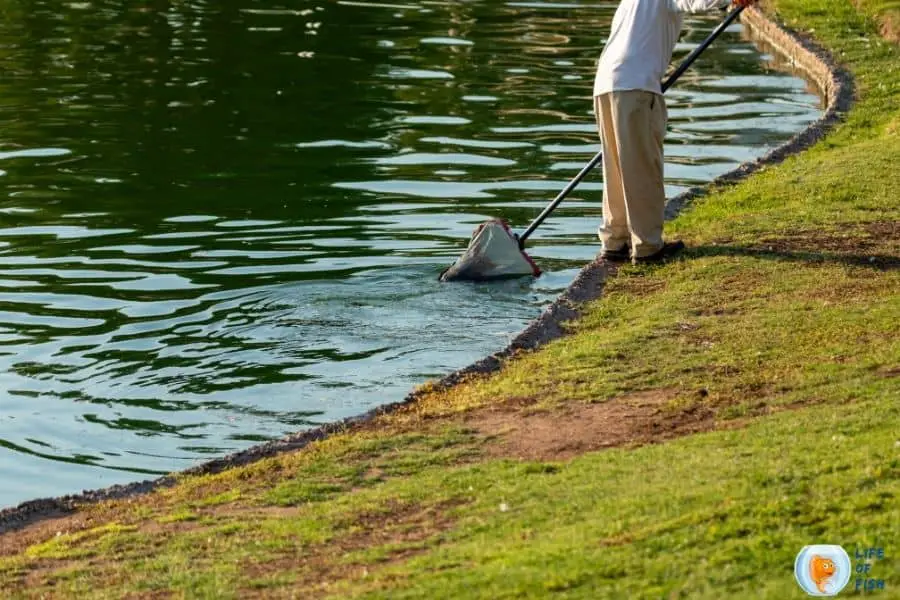
Common Problems You may face while owning a Pond.
A pond is an investment that may provide you with leisure, beauty, and added value. Pond Maintenance and Cleaning is a commitment that needs some upkeep and expertise.
Ensure proper pond water parameters are present. It is the most critical factor to consider for anyone looking for a healthy pond to raise their fish.
If you own a pond, the most common difficulties you may face are:
Green Water (Phosphate levels)
Phosphates may enter pond water in many ways. Phosphate levels in the water are a significant contributor to both green water and the dreaded blanket weed.
The growth of undesirable algae will get restricted if phosphate levels stay low.
Ammonia and nitrites
Ammonia is discharged into your Pond when fish defecate. The bacteria break down ammonia and convert it to nitrite.
The nitrite gets broken down into nitrate after this stage. Ammonia levels must be monitored and controlled to keep them as low as possible, as ammonia poisoning can be lethal to your fish.
Oxygen Depletion (Dying Fish)
Have you observed that your fish is acting strangely, or have you lost several fish at once?
In that case, oxygen deprivation might be the main cause.
If your fish spend a lot of time at the surface, sometimes gulping air, or if your Pond stinks, you probably don’t have enough air circulation.
Algae Growth
The most prevalent issue is algae. Pollution, light exposure levels, water velocity, turbidity, and temperature are all factors that might create large algal blooms and surface coverage in your Pond.
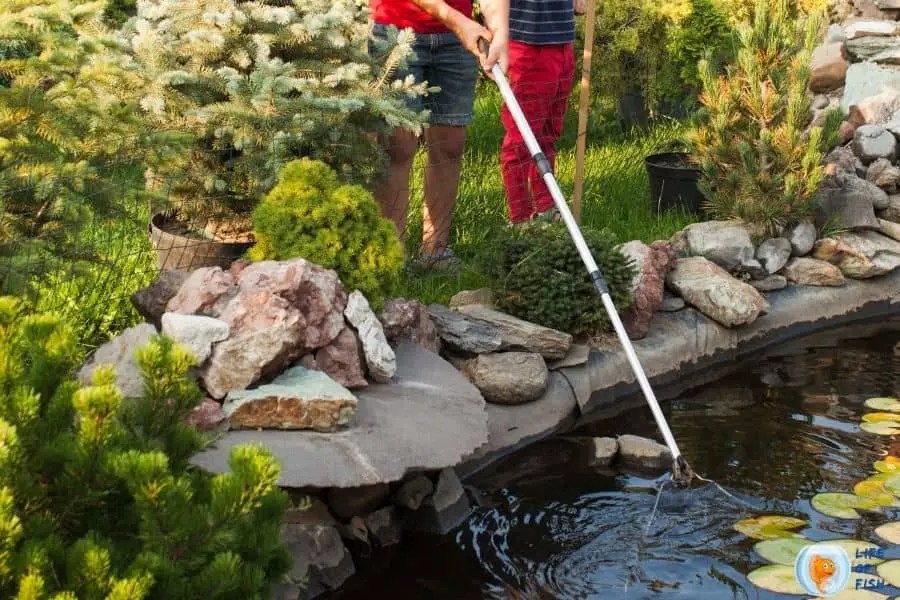
4 Easy Steps for Pond Cleaning
Depending on the location of your Pond, you may need to do a clean once or twice a year.
If you’ve been wondering how to clean a pond by yourself, these are a few simple steps for you to follow.
Step 1: Drain the Pond Water
If you have a pond in your yard, ensure the water gets drained from the bottom and the surrounding environment.
If you have fish, fill the holding pool with pond water to keep them from jumping out. Keep the fish in the water for no more than a few hours.
Step 2: Gentle Cleaning
A pond of average size (11′ x 16′) should take around 15 minutes to complete. Rinse the pebbles and gravel with a moderate stream from a garden hose.
To remove the filthy water, switch on the clean-out pump. Once the water washing down to the bottom seems clean, you can stop pumping.
Step 3: Cleaning of Pond Filters
If you have a skimmer in your Pond, clean any material from the filters. Rinse the filters to remove any debris that has accumulated after eliminating them.
It’s possible that the filter media and matting need to be replaced, following which the skimmer’s waterfall pump may get linked again.
Step 4: Water Treatment
Fish cannot exist in any type of water. Our drinking water is treated with chlorine, fluoride, and other chemicals to ensure safe drinking.
Those things irritate fish. The water needs to get treated to make it safe for them to live.
Fill the Pond with water from your garden hose, then add Pond Detoxifier to make the water healthy for your fish.
Fill a five-gallon bucket with water and set it in the fish holding tank; after 15 minutes, begin filling the bucket with pond water.
You may now release the fish into their freshly cleaned environment.
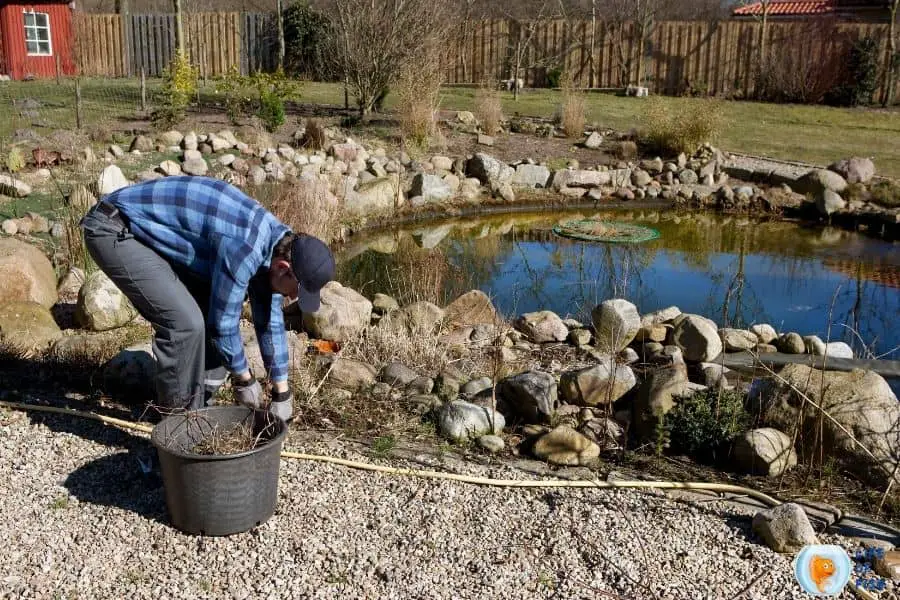
How To Do Pond Maintenance? Tips For Sustaining a Clean Pond
Pond cleaning can take a lot of time; However, after you have done all the hard work, it’s time for you to maintain a cleaner pond.
Many ponds have been left green, filthy, and stinky due to misdirected or missing upkeep. Understanding your Pond’s environment may make or break your upkeep efforts.
Nature will take care of the rest if you get it correctly. Here’s all you need to know.
Pond aeration
The process of introducing oxygen to water is known as aeration. It’s an integral part of any pond owner’s success in keeping their ponds clean and healthy.
Aerating in your Pond, whether it’s a tiny ornamental pond, a koi pond, a bigger pond, or even a small lake, will help maintain it clean.
Aerating your Pond can help prevent algae development and even lessen the amount of muck that accumulates at the bottom.
You have numerous options when it comes to aeration. Bottom diffusion aeration is an excellent choice for a reasonably deep pond.
Consider surface aeration, such as a waterfall, for a shallower pond. It will assist stir the water, but it will also be beautiful to look at, which is an added advantage.
Special Care During Summer:
When water temperatures rise beyond around 70 degrees Fahrenheit, oxygen levels plummet, making life quite miserable for your fish.
Check that your Pond’s pump is operating correctly, and consider using a supplementary aeration device, such as a fountain, to keep the water circulating and a little cooler.
Add The Suitable Plants
Suitable Plants may be an excellent addition to any pond.
During the hottest months of the year, plants may assist keep water temperatures lower and offer much-needed cover for fish and other aquatic life.
Floating plants stifle algae development and consume part of the nutrients that algae require to thrive. Some plants even help to oxygenate the water in your Pond.
Beneficial Bacteria
Adding beneficial bacteria to your Pond is one of the simplest methods to decrease excess nutrients.
The bacteria will consume the green organic matter and sludge, increasing the water’s quality and clarity.
When coupled with an aeration system, beneficial microorganisms may make pond maintenance a straightforward task.
Colorants can also get added to your Pond. They may reduce the temperature of a pond as well as improve the color of the water.
Adding appropriate Fish
The pond ecology would be incomplete without our aquatic buddies. Fish eat algae, as well as plants and insects that they find in the water.
People are also greatly influenced by fish. It’s pleasant to watch fish, much as it is to watch a fire in the fireplace! Some people are hesitant to eat fish.
However, one of the most admirable aspects of owning a pond is hosting these underwater beauties.
Recirculation of Water
A pond pump serves two purposes. It not only filters the water but also helps to oxygenate it. It allows the bacteria and fish to conduct their jobs.
Moving water is an integral part of a pond’s ecosystem, and it also looks good. A waterfall is the most striking feature of a pond for most people.
Raking Your Pond
Raking your Pond is an excellent technique to get rid of algae and debris, as well as mud. If you have a bigger pond, you should go out with your rake once a week to clean it out.
A pond rake is cheap, and while raking out the Pond takes time, it doesn’t have to take long if you do it once a week.
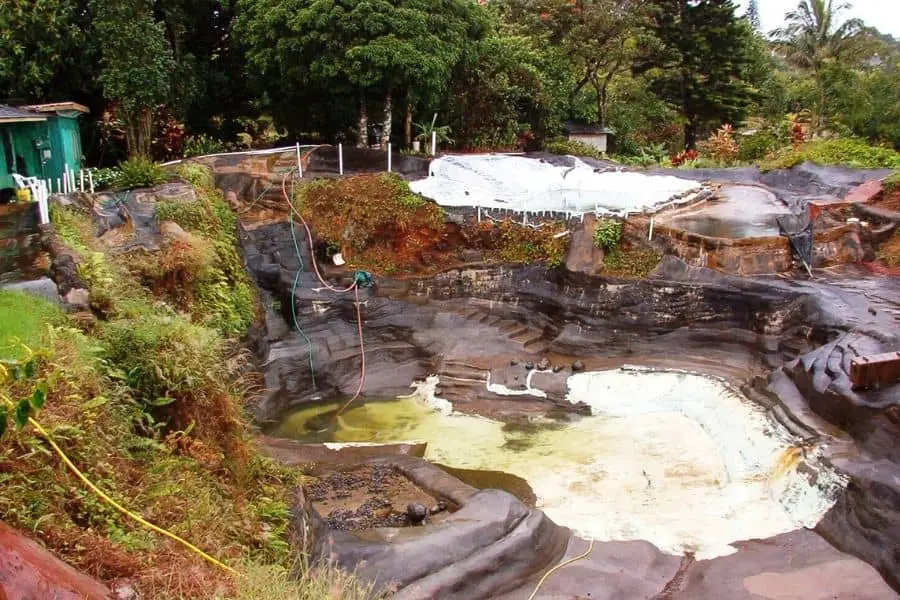
Your Pond Maintenance Time Schedule Will Keep You On Top Of Your Pond Care
Once all of the components of the pond ecosystem are in place. Several things might harm your Pond, and you must address them if you want to maintain a healthy garden. Here’s a timetable to help you stay on track.
Feeding you Fishes– Time Required: 2 minutes
Give the fish something to eat. It’s not a chore; it’s a requirement. But don’t worry if you’ll be gone for a few days. To survive, the fish can consume the pond debris.
Check On Water Levels – Time Required: 5-10 minutes
Ascertain that the water level is appropriate. A pond will lose a tiny amount of water due to evaporation and splash.
It’s now only a matter of keeping an eye on it. Every Pond is different, but at the absolute least, check the water level once a week.
Again, this isn’t a difficult task; you don’t have to sit by your Pond.
Schedule to Empty Skimmer Basket – Time required: 1-2 minutes
Make sure the skimmer basket is empty. It should be repeated every two to three days typically, or else immediately after a storm or a windy day.
We strongly advise using a net in the fall to keep lots of leaves out of the water. Your pond netting may be surprisingly inconspicuous while also saving you time and effort.
Plant Trimming. – Time Required: 15 minutes per month, approximately
Plants should get trimmed often. You won’t have to bother about this till the plants are fully grown.
The amount of time required gets determined by the number of plants you have.
Add bacteria – Time required: 1 to 5 minutes
Add bacteria to the mix. It’s as easy as sprinkling some powder into the water. Set aside 1 minute every week or 5 minutes every two months to change the bacteria doser packet.
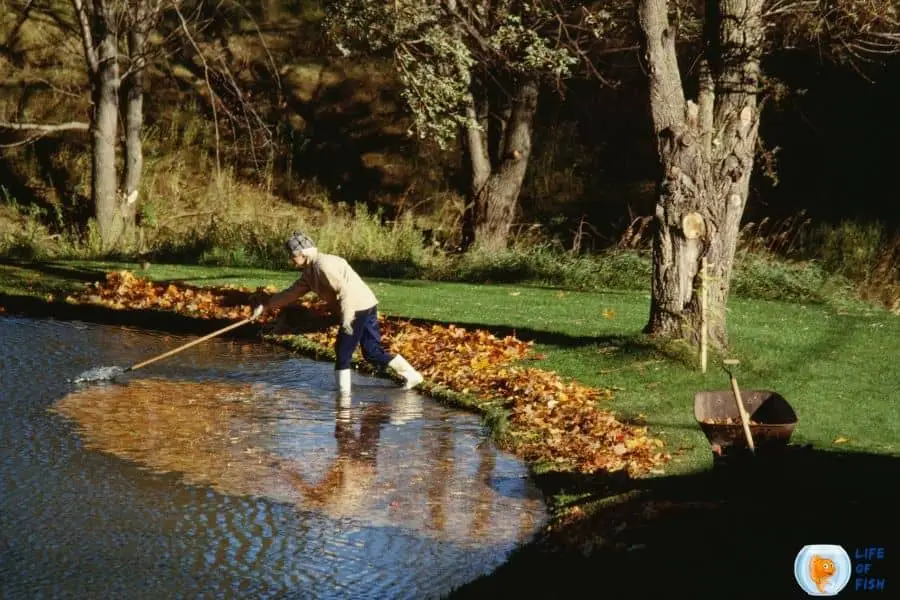
Conclusion
Pond Maintenance and Cleaning doesn’t have to be time-consuming, especially if you have a well-designed filtration system and pump.
When the temperature of the water rises, organic debris can develop, making Pond cleaning more difficult.
Maintaining a healthy water temperature makes pond care easier. It’s also crucial to keep an eye on water levels to ensure that you have enough water to support all of your underwater life.
So, if you have any grey spots on the points we discussed, please let us know your concern in the comment section; we will respond to you in a jiffy. Have a great day!
Read Next: Super Easy Beginner Guide Of How To Keep Algae Out Of Pond?
